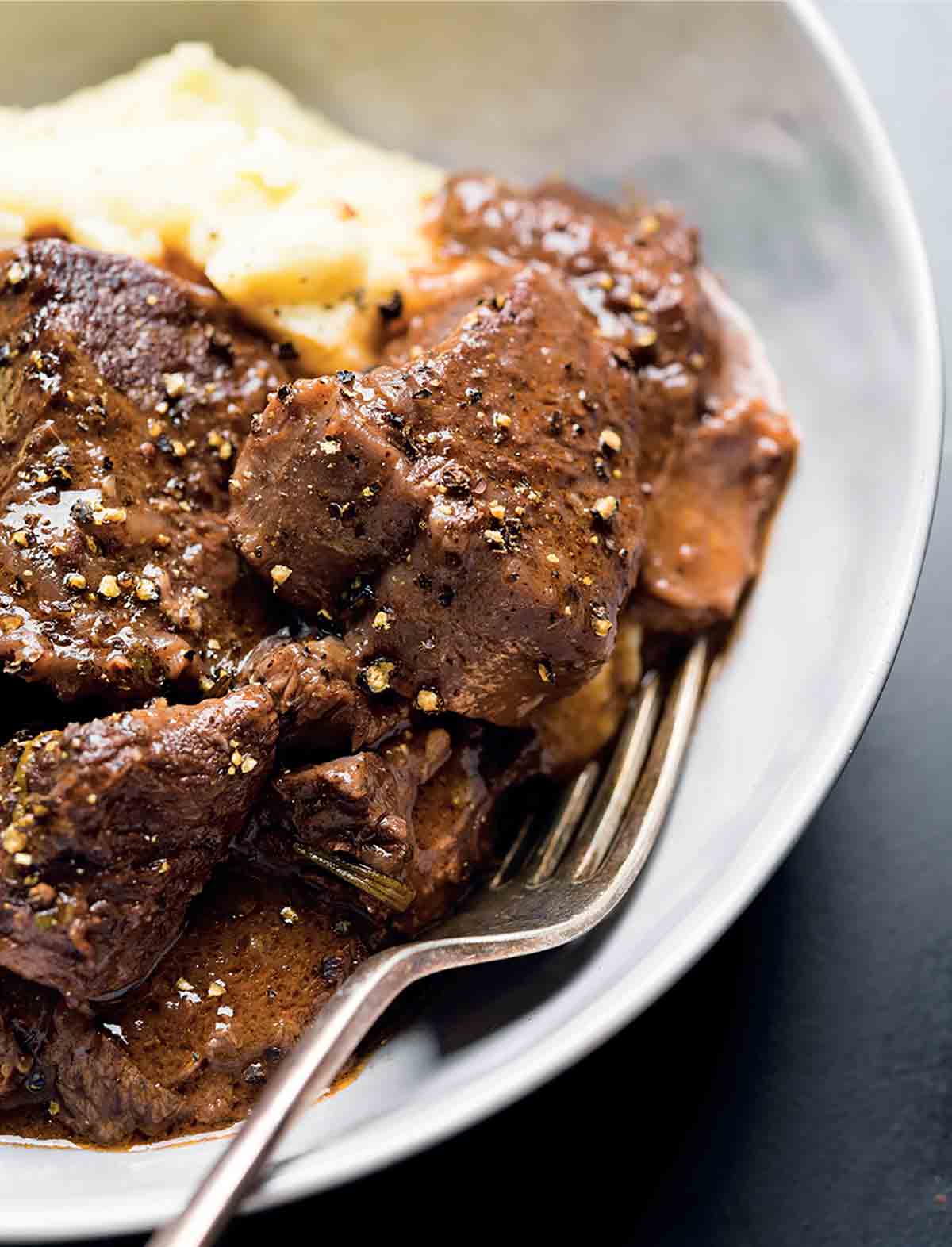
The simple, generously peppered beef stew known as peposo alla fornacina is said to have been created by 15th century kiln (fornacina) workers in Tuscany, Italy. Chianti is the best-known wine produced in that region and is the traditional choice for peposo, but any dry, medium-bodied red wine works. The stew keeps well, so it can be made up to three days ahead and reheated in the microwave or in a saucepan over low. It’s especially delicious with soft polenta or Ina Garten’s mashed potatoes.
Don’t use finely ground black pepper. Coarsely ground pepper has more presence in this braise and gives it character. For best flavor and aroma, it’s best to start with whole peppercorns and pulse them in an electric spice grinder until coarsely cracked.–Christopher Kimball
What type of red wine do you use for beef stew?
Any dry red wine will work, such as Syrah, pinot noir, even a blend of red varietals. It’s traditional in wine-making lands to use a style of wine from the region in which a recipe originated, which means you really can’t go wrong with any Tuscan red in this recipe.
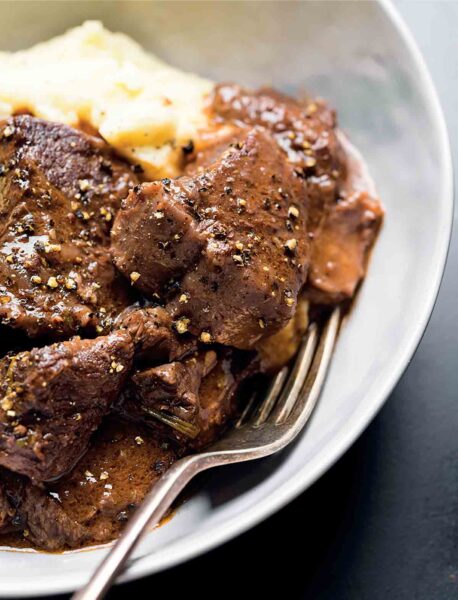
Beef Stew with Red Wine
Ingredients
- 2 tablespoons extra-virgin olive oil
- 1 large (12 oz) yellow onion, halved and thinly sliced
- 12 medium garlic cloves, smashed and peeled
- 2 cups dry red wine
- 3 tablespoons store-bought or homemade tomato paste
- 2 sprigs fresh rosemary, plus 1 1/2 teaspoons minced
- 4 pounds boneless beef chuck roast, trimmed and cut into 1 1/2-inch (4-cm) chunks
- Kosher salt and coarsely ground black pepper
- 3 tablespoons all-purpose flour
Instructions
- Grab your 6-quart Instant Pot and select More/High Sauté. Add the oil and heat until shimmering. Add the onion and garlic and cook, stirring occasionally, until the onion is lightly browned, 6 to 7 minutes.
- Add the red wine and cook, stirring and scraping up any browned bits, until reduced to about 1/2 cup, 12 to 15 minutes.
- Stir in the tomato paste, rosemary, and 1 tablespoon pepper. Stir in the beef and 2 teaspoons salt and then distribute in an even layer.
- Press Cancel, lock the lid in place, and move the pressure valve to Sealing. Select Pressure Cook or Manual; make sure the pressure level is set to High. Set the cooking time for 25 minutes.
- When pressure cooking is complete, let the pressure reduce naturally for 15 minutes, then release the remaining steam by moving the pressure valve to Venting. Press Cancel, then carefully open the pot.
☞ TESTER TIP: If your beef isn’t as tender as you’d like, go ahead and pop that lid back on and bring up to high pressure for 10 to 15 minutes more, then use quick release to vent the steam.
- Using a large spoon, skim off and discard the fat from the surface of the cooking liquid.
☞ TESTER TIP: If you prefer only a minimal amount of fat in your stew—keep in mind, fat has flavor—use that gravy separator you otherwise use only at Thanksgiving or refrigerate or freeze your pan juices until the fat congeals on top and can easily be skimmed.
- In a small bowl, whisk the flour with 6 tablespoons of the cooking liquid until smooth, then whisk it into the pot. Select Normal/Medium Sauté. Stirring occasionally, bring to a simmer and cook until slightly thickened, 6 to 8 minutes.
- Press Cancel to turn off the pot, then stir in the minced rosemary and 1 to 1 1/2 tablespoons pepper. Taste and season with salt.
Notes
Oven-Braised Method
No Instant Pot? No worries! This stew can easily be made in your oven. In a Dutch oven, brown the meat in batches, set the meat aside, and follow the recipe above. After returning the meat to the Dutch oven, cover and cook at 325°F (163°C) until tender, checking occasionally and adding a little beef stock or water if the liquid level is low, 90 to 110 minutes. Continue the recipe from step 5 on your stovetop.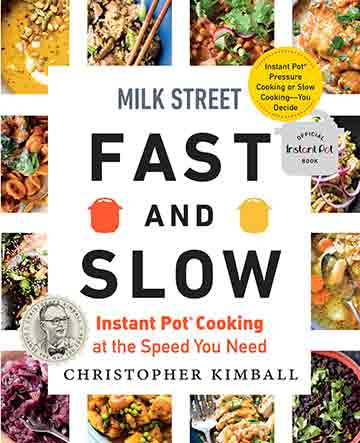
Nutrition
Nutrition information is automatically calculated, so should only be used as an approximation.
Recipe Testers’ Reviews
Oh, my. This is a fabulous dish, and might just be my go-to beef stew from now on. The ingredients are so humble, but the result is superb. The pressure-cooked meat was perfectly tender, falling apart, juicy, and imbued with aromatics.
I used a Bordeaux. The minimal seasonings let excellent quality meat shine here. It took a full 18 minutes to come to pressure and I was anxious that it was never going to get there. I would recommend to add a bit more liquid next time. Perhaps 1/2 cup of the reduced wine just wasn’t enough for the large quantity of meat.
Also, the leftovers are wonderful and are sustaining us through the declining temperatures. This will be a go-to dish during the winter months, paired with mashed potatoes or homemade biscuits.
We served it with:
Night 1: Biscuits and roasted Brussels sprouts
The stew is wonderful to dip homemade biscuits in!
Night 2: Mashed potatoes—fabulous!
The dish is not particularly beautiful; I would garnish it with parsley next time.
This is a wonderful, thick, full flavored stew. I don’t think I’ve ever made a recipe that uses pepper in this way…why?! It created such wonderful flavor in this dish! It was reminiscent of something familiar, but I can’t recall a dish I’ve made that produces this unique flavor. (If I could guess, maybe I had something with a similar flavor in Italy?!) This surprised me, because the ingredients are not anything new, yet all together, with that amount of black pepper, it was totally different. This is not a sharp pepper, but a deep, round, in your entire mouth spiciness. I love spicy, but I don’t want my taste buds to be numb—I like to be able to taste other flavors. This is that kind of pepper! As you can tell, the flavor totally surprised me in the best way.
I made this in a Le Creuset enameled cast-iron dutch oven. I used a Montepulciano d’Abruzzo. I followed the slow method pretty closely. When I first added the meat, there wasn’t much liquid in the casserole and I thought I would have to keep a close watch and add more liquid. After about 20 minutes, I added 1/3 cup water. I checked after another 20 minutes and the ingredients had exuded enough liquid that I did not add more. I checked after another 15 minutes, and no extra liquid was needed—and it never needed any extra after the first 1/3 cup. I do recommend adding the 1/3 cup, though, right at the start of the long cooking to prevent any initial scorching.
After 7 1/2 hours, the meat was beautiful and tender, and some pieces were falling apart, so if cooking in a Dutch oven, I would recommend checking it after about 5-6 hours for tenderness. It actually produced a nice combination of whole pieces and some meat falling apart, but with subsequent reheating, there were few large pieces.
I added the initial 1 tablespoon pepper, and at the end, I added 1 tablespoon more, (as opposed to 1 1/2 tablespoons), (so 2 tablespoons total in the recipe for me) and the flavor was perfect for my taste—this yields a deep, pleasant, warming, peppery taste. Maybe I’d add the extra 1/2 tablespoons next time, but the pepper was so wonderful with 2 tablespoons total I’m not sure I would change a thing.
We had it with polenta and it was amazing. We had some leftovers over pasta, like a ragu! I agree, as the recipe notes, it would also work with mashed potatoes. Rosemary complements well and should not be skipped—it adds further deep woody flavor. Red wine went perfectly with it. This is for a homey, warm, feel like you’re in Italy during wild boar season recipe!
I really love how anything cooked in a pressure cooker defies the laws of physics. I made the “fast” version of this recipe and the meat was tender and falling apart in less than an hour but tasted like it had been cooking for hours! I do think 12 cloves of garlic is a bit overkill and 4 to 6 would be plenty.
I gave it another 12 minutes at high pressure because I wasn’t satisfied with the level of doneness at 25 minutes. I served it with polenta and steamed rapini and my husband declared that the meal was almost too fancy to eat on a weeknight. I declare that a success! I used Baco Noir.
I made the fast method; I cooked it for 25 mins high pressure; natural release for 20 mins… and when I opened the lid, the meat wasn’t as tender as I would have liked, so I sealed it up again for another 12 mins at high pressure and quick release. It was perfect… so I would probably instruct cooks to use high pressure for 35 mins.
I served it with polenta and steamed rapini. This serves 6 to 8 people. It was VERY hearty. I would say this could easily be cut in half.
As the weather is turning colder, one’s mind turns to a good stew or soup. I’ve spent time in Tuscany, and yet never came across this particular recipe before. My Instant Pot cooker was purchased many years ago and had been collecting dust in the pantry, so it was fun to pull it out and test drive it again. Cooking this beef stew in the Instant Pot turned my typical all-day braise into a very quick and easy dinner.
There are really no special ingredients required for this dish. I did use a nice Tuscan wine for the recipe, and I ground up peppercorns in my spice grinder to get as fresh pepper as possible for a nice peppery bite. It did take a bit longer for my cooker to achieve pressure, it may be the age of my unit has something to do with that, but the overall time from sealing the lid to releasing the steam was almost an hour, so be sure to add a bit more time if in a hurry.
I used a Tuscan red blend. I did scoop off as much of the beef fat as possible by hand, then I poured the rest of the broth into a fat separator to remove as much fat as possible from the dish. Whisking the flour and broth into a slurry works wonders, as its final result was a nice, smooth gravy for the beef. Next time, I might place the stew in the fridge for a few hours to let the fat coagulate, then remove it, bring the stew to a simmer, and add the slurry.
The stew is very thick and yet mildly spicy with pepper that lingers a bit after each bite. I served it with smashed olive oil-roasted red potatoes and butter roasted carrots to give the stew a bit more texture.
Colder weather brings warmer clothing to wear and warmer dishes to savor. This Tuscan beef stew suits this season to a tee. Laced with delicious Chianti, fresh spices, and herbs, the aromas wafting from my kitchen this chilly weekend helped to bring some welcomed warmth.
I was fortunate enough to visit a wonderful butcher shop in Panzano, Italy, 2 years ago. We were treated to watching a classic pepsoso prepared early in the day, and lucky enough to return to enjoy it at dinner time. Interestingly, scraps of beef butchering were the go-to ingredient there, nothing wasted in Italy, and rather than use an Instant Pot, it was slowly braised in a large iron kettle for most of the day, left to bathe in delicious wine and herbs, just as is called for in this recipe.
The trimming of the chuck roast to 4-cm chunks was just perfect. I chose to use the low-and-slow method and braised it in the oven at 325°F.
This stew is a wonderful addition to anyone’s savory winter cache. It all worked beautifully, was wonderfully simple to prepare, and brought back some delightful memories that I never thought I would be able to replicate. With travel restricted, this will be your virtual trip to Tuscany!
I used a Chianti Reserva. I put the pot, covered, in the middle of the oven and tested the chuck after 1 hour. It was still tough. I then tested it at 20-minute intervals, rotating it 180° each time. Total time in the oven, from start to finish was 1 hour and 50 minutes. The meat was just beautifully cooked at that time, with a little resistance but intact.
I was able to cool the pot on the counter and then refrigerated the stew until the following afternoon. I then removed it and skimmed off the solidified fats from the surface. I slightly heated it and whisked the slurry of 3 tablespoons flour with 6 tablespoons cooking liquid. I added this gradually and found that using 2/3 of this mixture was enough to thicken the stew nicely after 6 to 8 minutes, as noted. It was then heated through.
I think the stew would generously serve 6. Certainly, some root vegetables could be added, which would help to stretch the dish. I served it with smashed butternut squash and freshly made Tuscan bread.
This was an amazing dish! It was perfect for a cold fall evening. I love the ability to cook it for a weeknight dinner or let it simmer all day while at work or playing in the snow. It has flavors that remind me of bourguignon but a richness all it’s own. I was really skeptical about the large amounts of rosemary and black pepper, but the end product was so well balanced!
It’s also classy enough for an effortless dinner party, and it would appear you spent the whole day in the kitchen. I can see myself making this often. I used cabernet sauvignon. I served it with goat cheese polenta and it was amazing.
I can’t say much more than that I thought this was delicious. The combination of beef and pepper in an incredibly rich and satisfying sauce is something I’m looking forward to again for dinner on a cold winter night. On top of that, it was so easy to put together. Trimming the fat from the chuck roast took a little bit of time, but my goal was to get rid of as much of the large areas of fat as possible. Given the amount of marbling throughout the cut, it was challenging to accomplish without removing portions of the beef as well, but still worth the effort. I chose the fast method for this recipe and the timing was perfect for producing extraordinarily tender meat and for almost all the steps.
I used pinot noir. I ground whole peppercorns to a coarse texture using an electric grinder. The noticeable bits of pepper in the stew were definitely a high point for the flavor and texture they added. I served it with soft polenta.
I made this last night using the 15th-century method of my Dutch oven. The recipe was easily modified and came together perfectly. Black pepper is one of my favorite spices so this will be in the rotation for the winter.
First I browned the beef in 5 batches and salted it as I went. I used a Salcheto Chianti (super smooth!) and simmered for 15 minutes. While that was simmering I used a mortar and pestle on 1 tablespoon of peppercorns. When the wine was reduced to 1/2 cup, I added the tomato paste, rosemary sprigs, pepper and the beef with all of its juices. There wasn’t a lot of liquid in the pot so I did add 1 cup of beef stock. I gave everything a stir, put the lid on and put the pot in a 325°F convection oven for 1 hour and 15 minutes.
What came out was heavenly. The sauce was absolutely luscious and I almost skipped adding the flour and sauce mixture, but I did and simmered it for 8 minutes to smooth everything out. I added the additional tablespoon of cracked pepper and minced rosemary. My husband requested quinoa instead of mashed potatoes and the stew was fantastic. The warm rosemary and tomato flavors and the spicy pepper are perfect complements to the tender beef.
I just had a small bowl for lunch and the pepper is a bit more pronounced but I don’t mind that at all. Mashed potatoes would be an excellent choice with this. For such simple ingredients, this is a luscious and complex stew.
I don’t know if I can make beef stew any other way after this. It was so easy, so flavorful, and so fast. I used the faster pressure cooker cooking method and the finished product was flawless.
Take care to buy a nice wine because it definitely plays a part in marrying the flavors of the pepper and rosemary. I used a smoky Chianti that worked wonderfully (and tasted nice to drink with the stew as well). The meat was perfectly tender after the recommended cooking time. I served it over mashed potatoes for a very rich and filling dinner.
Even though this is the fast method, it still took me about an hour and a half. My Instant Pot seems to take a while to come up to pressure. Still shorter than a stew slowly bubbling away all day on the stove!
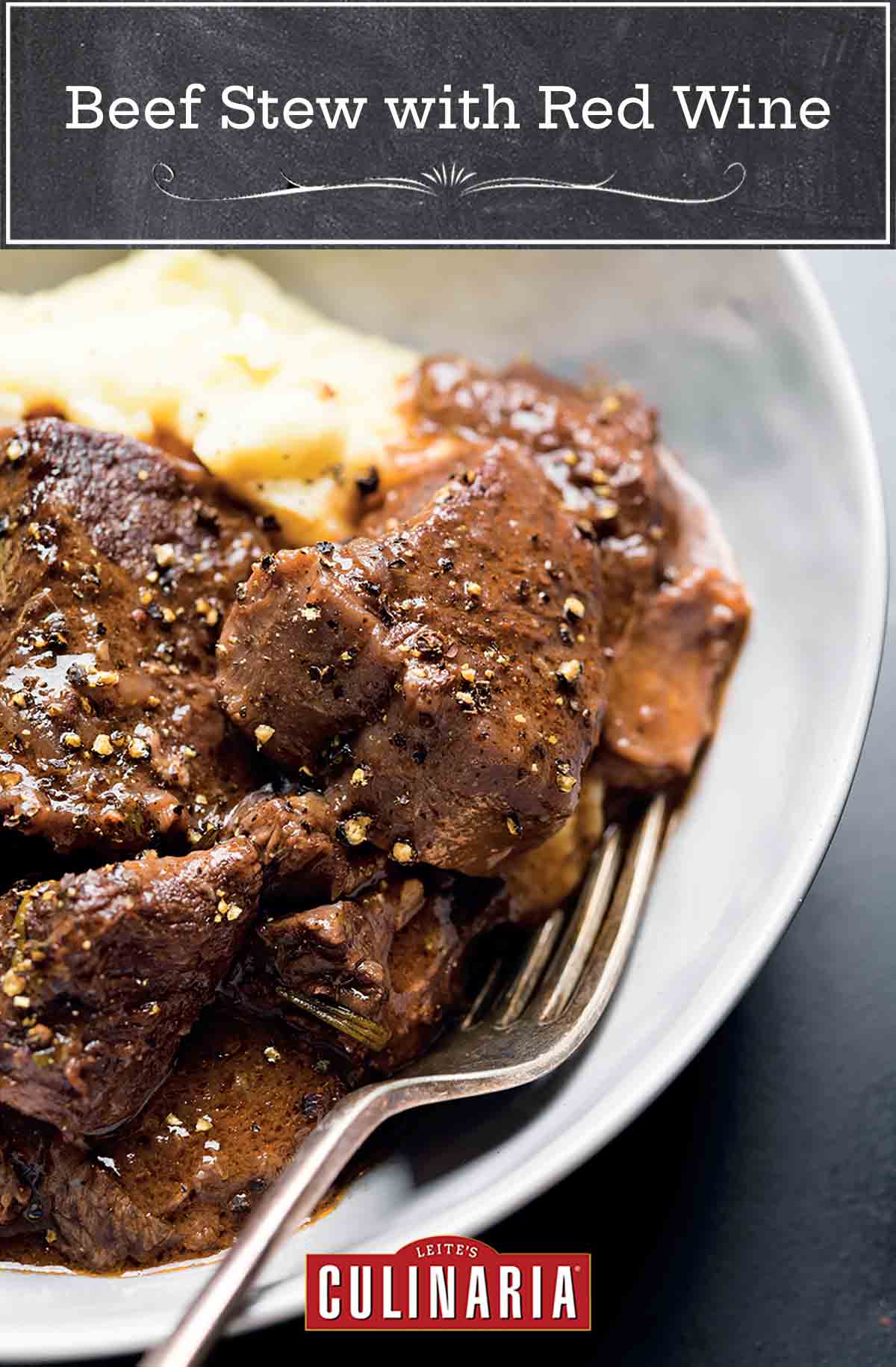





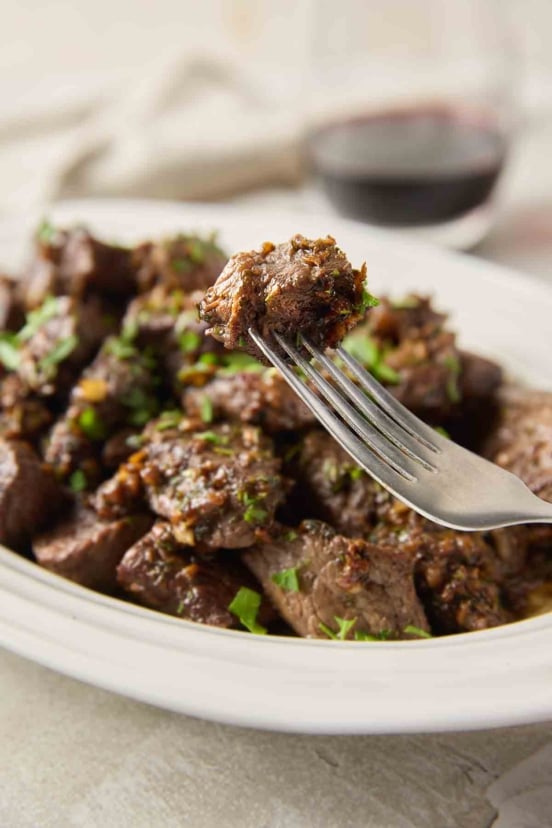
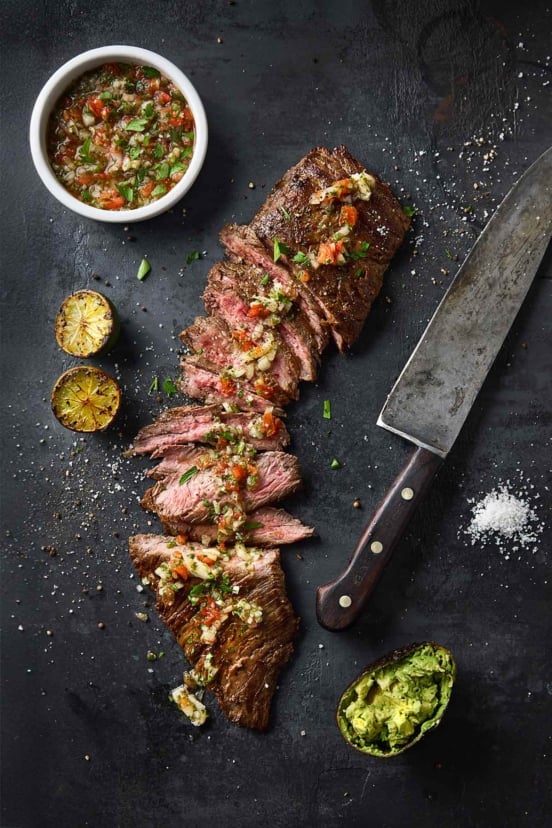
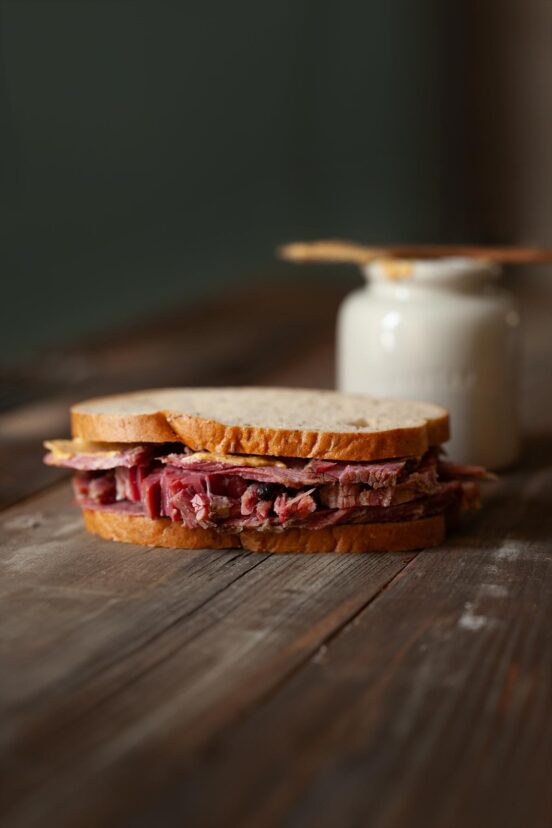









This stew never fails, and is possibly my favorite recipe on LC. I made it yesterday for a dinner party, served with garlic mashed potatoes and roasted carrots. It got rave reviews, and for my friends who were not able to attend last night I will happily make it again in a few weeks. I am looking forward to a few days of excellent leftovers, as I always make a huge pot of this stew!
Fantastic, Lisa! We are so thrilled that this is a never fail recipe for you and you always enjoy it. Thank you for taking the time to comment.
This recipe is simply extraordinary. Quite literally. I must confess I’ve made it twice during this cold, rainy week in coastal Maryland. I’ve greatly enjoyed adding my own vegetables when serving – my favorite by far was Curried Roasted Carrots and Black Pepper Mashed Potatoes, both on this site as well.
Thanks, Kristen. We’re so pleased that you love it. Thanks for taking the time to comment.
As someone already said, there is not much more to say than this was Delicious! This will be my go to for beef stew. I used the oven-braised method and found everything came together easily. I served with mashed potatoes but will try the homemade biscuits next time. Thanks for another tasty dinner.
You’re welcome, Tannis! Thank you for taking the time to let us know.